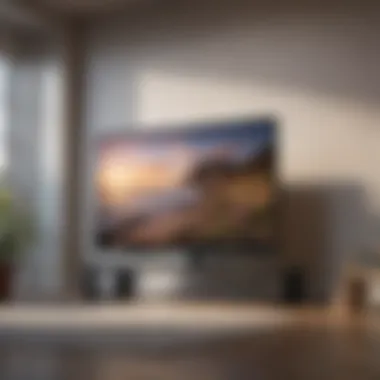Ultimate Guide to Safely Cleaning Flat Screen TVs


Intro
Cleaning a flat screen TV is often overlooked but is crucial for maintaining the quality of your viewing experience. Dust, fingerprints, and other residues can accumulate on the screen, leading to a foggy picture and overall dissatisfaction. Understanding how to properly clean your television not only helps in preserving its aesthetic appeal but also extends its lifespan, ensuring your investment continues to deliver high performance. This guide aims to provide homeowners and design enthusiasts with a thorough understanding of effective cleaning methods and the right tools to use.
Essential Cleaning Tools
To begin with, getting the right tools is vital. Here is a list of basic items you will need:
- Microfiber cloth: This is gentle and effective for dusting. Avoid regular cotton cloths as they can scratch the screen.
- Screen cleaning solution: A solution specifically designed for electronics, such as the ones from Zeiss or Endust, works well.
- Distilled water: Great for creating your cleaning mixture if you prefer a DIY approach. Tap water may leave residue.
- Spray bottle: This helps in applying the cleaning solution evenly.
Best Practices for Cleaning
Following the right practices ensures not just cleanliness but also the longevity of your flat screen. Consider these steps:
- Turn off the TV: Before any cleaning, ensure that your television is turned off and unplugged. This minimizes the risk of damage and lets you see smudges more clearly.
- Dusting first: Use a dry microfiber cloth to gently wipe away dust. Always move in a circular motion.
- Prepare the cleaning solution: If using a homemade solution, mix equal parts of distilled water and your screen cleaner in the spray bottle.
- Wipe the screen: Apply the solution onto the cloth, not directly onto the screen. Then, wipe the screen gently without applying excessive pressure.
- Use a second cloth: If the screen still has grime, you can use a second microfiber cloth for a final polish.
Regular cleaning can drastically improve your viewing experience and prolong the life of your TV.
Avoiding Common Mistakes
Many individuals make errors when cleaning flat screen TVs. Here are some to avoid:
- Using paper towels: These can scratch the screen and cause damage.
- Cleaning in direct sunlight: This can make it hard to see the smudges and may lead to overheating.
- Using window cleaners: Many contain ammonia, which can damage the screen coatings.
Culmination
Proper maintenance of flat screen TVs goes beyond mere aesthetics. A clean television not only elevates your viewing experience but also enhances the room's overall appearance. By incorporating the recommended practices and using the right tools, you can ensure that your investment remains protected for years to come.
Understanding Flat Screen TVs
To effectively clean and maintain flat screen televisions, it is essential to understand their basic functionalities and design variations. Different types of flat screen TVs possess unique characteristics, which can influence both the cleaning processes and the longevity of the devices. Grasping the distinctions between these types of televisions enables homeowners to apply tailored cleaning techniques that preserve the integrity and performance of their equipment. Additionally, understanding various features helps users to make informed decisions about how they care for their televisions.
Types of Flat Screen Televisions
Liquid Crystal Display (LCD) has been a popular choice in flat screen technology for many years. One of the key characteristics of LCDs is their ability to display vibrant colors and good contrast. LCD TVs tend to be lightweight and energy-efficient, making them an attractive option for many consumers. A notable feature of LCD technology is its wide viewing angles, which facilitates shared enjoyment in different areas of a room. However, it is important to note that LCDs can suffer from issues such as backlight bleeding and limited contrast ratios compared to other types.
LED
Light Emitting Diode (LED) televisions are essentially a subset of LCDs, distinguished by their use of LED backlighting instead of traditional fluorescent tubes. The predominant advantage of LED technology is that it can produce deeper blacks and heightened brightness. This capability leads to a more immersive viewing experience. Furthermore, LED TVs are typically more energy-efficient compared to their LCD counterparts, benefiting both the environment and user's electricity bills. However, like LCDs, LED TVs can experience issues like blooming effects, where bright objects bleed into darker areas of the screen.
OLED
Organic Light Emitting Diode (OLED) technology offers a significant advantage due to its self-emissive nature. Each individual pixel in an OLED screen emits its own light, resulting in exceptional color accuracy and greater contrast ratios. This feature allows for incredibly thin screens that can achieve true blacks, enhancing overall picture quality. As such, OLED has become a highly sought-after choice among enthusiasts of home entertainment. However, these televisions can be prone to screen burn-in, where static images can leave a permanent mark on the display over time.
Plasma
Plasma televisions, which were once a dominant choice in large screen formats, operate using gas-filled chambers that emit light when energized. A key characteristic of plasma displays is their capability for excellent motion handling and deeper blacks, which contributes to an engaging viewing experience, especially for films and sports. However, plasma TVs are generally heavier and consume more power than LED or LCD models. Furthermore, while they have rich colors, they tend to suffer from screen burn-in, similar to OLEDs, and are no longer widely produced.
Common Features and Designs
Screen Resolution


Screen resolution refers to the number of pixels displayed on a screen, with higher resolutions resulting in sharper images. Full HD (1080p), 4K (2160p), and 8K (4320p) are common terms. Higher screen resolution is a beneficial hallmark for flat screen televisions, as it enhances the overall viewing experience. It is vital to consider resolution when selecting a cleaning method, as high-resolution screens may require more care to avoid scratches or damage during the cleaning process.
Smart Features
More modern flat screen TVs come equipped with smart capabilities, enabling users to access online content and streaming services directly. A key advantage of smart features is the convenience they provide, allowing users to switch effortlessly between channels and platforms. However, maintenance of these features requires additional caution. Dust and debris may accumulate in the ports and internal components, necessitating careful cleaning to preserve functionality.
Screen Coatings
Screen coatings can significantly affect the image quality and durability of a television. Anti-glare and anti-reflective coatings help improve visibility in bright rooms, while oleophobic coatings deter fingerprints and smudges. These features can benefit the cleaning process by reducing the frequency of necessary maintenance. However, improper cleaning techniques can damage these coatings, negatively impacting the screen's performance. Thus, safeguarding these coatings should be a key consideration in any cleaning strategy.
Understanding these foundational aspects of flat screen televisions provides insight into the cleaning process, informing your choices on materials and techniques that will best protect your investment.
Importance of Regular Cleaning
Cleaning flat screen TVs may seem trivial, but it plays a pivotal role in preserving both the functionality and appearance of the device. Regular cleaning is essential for various reasons that impact picture quality, lifespan, and overall aesthetics.
Impact on Picture Quality
Dust and fingerprints can accumulate on the screen over time. This buildup not only affects the clarity of the picture but also can distort colors and reduce overall brightness. A clean screen ensures that the display remains vibrant and clear. Regular maintenance allows viewers to enjoy their favorite shows and movies with optimal color accuracy and contrasts. Additionally, a clean surface can limit glare issues, creating a more enjoyable viewing experience.
Extending Television Lifespan
Microscopic particles of dust and dirt can find their way inside the TV, potentially causing overheating by blocking ventilation paths. Over time, this can lead to component failure, which shortens the device’s lifespan. By regularly cleaning the exterior and ensuring the vents are free from obstructions, users significantly reduce the risk of overheating and extend the life of their television. Moreover, addressing minor issues before they escalate can save considerable costs on repairs or replacements.
Maintaining Aesthetics
A cluttered, dusty TV can negatively impact the aesthetics of a living space. A clean television complements the interior design, whether in a minimalist setting or a more vibrant one. Regular cleaning involves not just the screen but also the frame and stand. Keeping these areas tidy enhances the overall look of the setup. Furthermore, a well-kept TV reflects a sense of care and attention to one's home environment, aligning with the standards of design enthusiasts who appreciate the synergy between technology and decor.
Choosing the Right Cleaning Materials
Selecting appropriate cleaning materials is crucial for maintaining the integrity of flat screen TVs. Using the wrong tools can cause damage or reduce the performance of the screen over time. Therefore, it is essential to consider both the materials and methods used in the cleaning process.
Microfiber Cloths
Benefits of Microfiber
Microfiber cloths are exceptionally effective for cleaning screens. Their unique structure allows them to lift dust and grime without scratching the delicate surface. The key characteristic of microfiber is its ability to trap particles. This is due to the split fibers that create more surface area. This feature is ideal for avoiding streaks and smudges.
A significant advantage is that they can be used dry or damp. When used dry, they efficiently collect dust, while a slightly damp cloth allows for more thorough cleaning of smudges. This versatility makes microfiber a popular choice in this guide.
Recommended Types
When choosing microfiber cloths, it is best to opt for those specifically designed for electronics. These tend to be softer and lint-free. Look for cloths that are labeled as "non-abrasive." A beneficial aspect of these recommended types is their reusable nature, allowing for long-term cost savings.
Unique features may include different sizes and stitches, which can provide different cleaning options. However, ensure that the cloths are free from any additives, as these can potentially harm the TV screen.
Cleaning Solutions
Specialized Screen Cleaners
Specialized screen cleaners are formulated specifically for electronic screens. They are a beneficial choice because they offer a gentle yet effective cleaning action that does not harm coatings. The key characteristic of these cleaners is their pH neutrality, which helps to maintain the screen's integrity.
These products often have anti-static properties. This reduces the chance of dust accumulation after cleaning, which is quite an advantage for maintaining a pristine display. It is important to follow the directions provided to avoid any potential issues.
DIY Cleaning Solutions


DIY cleaning solutions can be an alternative to commercial products. A common mixture consists of distilled water and white vinegar. This is a popular choice due to its simplicity and effectiveness. The key aspect of DIY solutions is their accessibility, as most people already have these ingredients at home.
A notable unique feature of DIY solutions is the ability to customize the mix according to personal preferences. Although generally safe, caution is needed to ensure the solution does not contain harsh chemicals that could damage the screen over time.
Avoiding Harmful Agents
Alcohol-based Products
Alcohol-based products can be tempting for many due to their availability. However, their use on flat screen TVs is not advisable. The primary risk is that these can strip protective coatings, leading to potential screen damage. A key characteristic of these agents is their effectiveness in removing tough grime.
Nonetheless, this effectiveness comes at a cost, as prolonged use can diminish the quality of the screen over time. Thus, their advantages do not outweigh the potential disadvantages.
Ammonia and Other Chemicals
Ammonia-based cleaners pose similar risks. These substances can cause discoloration and other forms of damage, particularly on delicate surfaces. The defining characteristic is their ability to cut through grease. However, this strength makes them unsuitable for flat screens.
Many household cleaners contain ammonia. Educating oneself on the ingredients before purchasing is critical. The unique disadvantage is that while these agents can clean effectively, they might cause irreversible damage, which is counterproductive to the goal of maintaining the television.
Step-by-Step Cleaning Process
Cleaning a flat screen TV requires a systematic approach to prevent damage and achieve optimal results. A step-by-step cleaning process not only ensures thoroughness but also minimizes risks related to the sensitive technology involved. This structured method covers everything from initial preparations to the final touches, making it relevant for anyone looking to maintain their television effectively.
Preparation Steps
Powering Down
Powering down the television is a crucial first step before cleaning. This not only protects the device from unexpected electrical issues but also minimizes the chance of screen damage. When a TV is on, the screen may be warm and more prone to scratches or other forms of harm. By turning it off, you create a safer environment for cleaning and allow any dust particles to settle. This act also aids in seeing smudges and fingerprints clearly, as the screen is typically more reflective when powered down. Overall, powering down is a simple yet effective choice for ensuring a smooth cleaning process.
Gathering Supplies
Gathering the right supplies is fundamental to successful cleaning. You need microfiber cloths, a designated cleaning solution, and perhaps an additional cloth for drying. The key characteristic of preparing these items beforehand is that it streamlines the cleaning process. When everything is at hand, it eliminates interruptions and allows you to focus entirely on the task. A well-chosen cleaning solution, like specialized screen cleaner, helps in effectively removing grime without causing damage. The disadvantage of not having these supplies ready is that it may lead to using improper materials, which can cause scratches or streaks on the screen.
Cleaning the Screen
Gentle Wiping Techniques
Gentle wiping techniques are vital when cleaning the screen of a flat screen TV. These techniques focus on using light pressure on the surface to avoid any potential damage, such as scratching. When using a microfiber cloth, make sure to wipe in circular motions rather than applying excessive force. This characteristic of gentle cleaning serves to prevent any visible marks or damages while also being effective in removing dust and fingerprints. Not using such techniques may result in damage, impacting the TV’s functionality and appearance over time.
Using Cleaning Solutions
Using appropriate cleaning solutions complements the gentle wiping techniques. A specialized screen cleaner or a DIY solution can effectively lift dirt and smudges without harming the screen. It is crucial to apply the cleaner directly to the cloth, not directly on the screen, to control the amount of liquid used. The unique feature of using designated cleaning solutions is that they are formulated specifically for delicate surfaces, enhancing the cleaning experience without risk. When finished, you may notice that the screen appears clearer and brighter, allowing for an enhanced viewing experience.
Cleaning the Surrounding Areas
Frame and Stand Maintenance
Frame and stand maintenance is an often-overlooked aspect of cleaning. Many focus entirely on the screen but neglect the areas surrounding it. Dust and fingerprints can congregate around the TV's frame and stand, which detracts from overall cleanliness. Regularly wiping these areas not only improves the aesthetics of your television setup but also helps in preventing dust accumulation. It’s beneficial to use a soft cloth for these areas, as harsh materials may scratch the finish. By maintaining frame and stand cleanliness, you prolong their lifespan and maintain a polished look in your living space.
Ports and Cables
Cleaning ports and cables is another important task during the cleaning process. Dust can easily accumulate in ports, potentially leading to connectivity issues over time. Using a soft brush or a can of compressed air can effectively remove debris without needing excessive force. Additionally, ensure that cables are dust-free to maintain organization and appearance. This focus on ports and cables helps in maintaining an efficient and clean setup, preventing future problems. Ignoring these aspects might result in performance issues, affecting how well your television works or how it integrates into your home entertainment system.
Best Practices for Maintenance
Maintaining a flat screen TV is critical for preserving both its performance and aesthetics over time. Regular maintenance can prevent buildup of dirt and grime, which can affect picture quality and lead to long-term damage. Implementing a series of best practices ensures that your investment continues to offer the best viewing experience possible.


How Often to Clean
Generally, the frequency of cleaning your flat screen TV depends on various factors such as environment and usage. Ideally, a thorough cleaning should be conducted every few months. If your TV is located in a dusty area or if you have pets, more frequent cleanings may be necessary, perhaps once a month. Regular dusting can be done weekly using a dry microfiber cloth to prevent buildup.
Monitoring the cleanliness of the screen is important. If you notice a decrease in picture quality or visible smudges, it may be time for a detailed cleaning. Following a schedule helps maintain clarity and extends the device’s lifespan.
Storage of Cleaning Materials
Proper storage of cleaning materials is essential for their longevity and effectiveness. Keep microfiber cloths folded in a clean, dry place to ensure they do not gather dust or foreign particles. Avoid cramming them into drawers or bags where they can become wrinkled or damaged.
Cleaning solutions should also be stored carefully. Keep them tightly sealed and in a cool environment to prevent degradation. This practice not only preserves their effectiveness but also safeguards against accidental spills that might damage your TV or nearby electronics.
Avoiding Common Mistakes
Proactively avoiding common mistakes can enhance your cleaning routine and protect your TV from unnecessary harm.
Using Excessive Force
Using excessive force while cleaning can scratch the screen or dislodge components. It is essential to wipe gently using a microfiber cloth, applying light pressure. The key characteristic of this approach is to be mindful and soft, which contributes to a better outcome.
In this context, excessive force can lead to permanent damage that might not be recoverable. Such damage could result in costly repairs or even replacement of the unit. Thus, gentle handling is a beneficial choice for maintaining the integrity of your TV over time.
Neglecting Power Down
Neglecting to power down your television before cleaning can lead to several issues, including overheating or electric shock if cleaning solutions accidentally enter the device. The basic characteristic here is safety, which cannot be overlooked. Powering down de-energizes the device, providing a safe cleaning environment.
Furthermore, this precaution minimizes the risk of screen burn-in, which arises from prolonged exposure to static images. Ultimately, taking the moment to ensure your TV is off is a simple yet effective means of preserving its functionality and safety.
Questions and Answerss About Flat Screen TV Cleaning
In the realm of home entertainment, flat screen televisions are valuable assets. The cleanliness and maintenance of these devices not only affect their appearance but also their overall operation. Understanding common questions regarding flat screen TV cleaning is essential. This section addresses frequent inquiries that users may have, providing clarity and easing concerns. By being informed, owners can ensure effective maintenance without risking damage to their investments.
Can use paper towels?
Using paper towels for cleaning flat screen TVs is generally not advisable. Paper towels often have rough surfaces that can scratch the delicate screen. Additionally, the fibers may leave behind lint, which is counterproductive for achieving a pristine view. It is recommended to use microfiber cloths instead. These cloths are soft and designed to capture dust and dirt without scratching the surface. For tough spots, lightly dampening the cloth with water is acceptable. Always test on a small area first to ensure there is no adverse reaction.
Is it safe to clean while the TV is on?
Cleaning a flat screen TV while it is on poses several risks. The primary concern is safety. There's a potential for electric shock if moisture gets into the device. Additionally, while the TV is operational, the screen's heat can cause cleaning fluids to evaporate too quickly, leading to streaks or residue. Turning off the television before cleaning is a prudent practice. This ensures not only the safety of the individual cleaning the screen but also improves visibility while removing dirt and smudges more effectively.
What if there are stubborn stains?
Stubborn stains on flat screen televisions can be problematic but not impossible to address. First, identify the source of the stain. Common culprits include fingerprints, food particles, or dust that has been allowed to sit too long. For these types of marks, a specialized screen cleaner specifically designed for TVs is recommended. If no such cleaner is available, a mixture of distilled water and white vinegar in equal parts can often work well. Apply the solution to a microfiber cloth, not directly to the screen, and gently wipe in circular motions to avoid streaks.
Always avoid spraying any liquid directly on the TV to prevent damage.
With patience and careful application, most stubborn stains can be removed without harming the television.
The End
Cleaning your flat screen TV is not just a task; it is a critical part of maintaining both the functionality and aesthetics of your device. The process we outlined in this article helps in preserving image quality. Regular cleaning can significantly enhance the lifespan of the television, allowing you to enjoy your investment for longer periods. Additionally, a clean screen contributes to the overall appearance of your entertainment area, ensuring that both the design and technology coexist harmoniously.
Recap of Key Points
- Understanding Types: Different flat screen types require distinct cleaning methods. Familiarity with LCD, LED, OLED, and Plasma technology is crucial.
- Cleaning Materials: Using the right cleaning materials, such as microfiber cloths and specialized solutions, will provide optimal results without risking damage to your screen.
- Cleaning Process: Following a step-by-step process ensures effective cleaning. This includes preparation, careful wiping techniques, and attention to surrounding areas like frames and ports.
- Best Practices: Maintaining regular cleaning schedules, proper storage of materials, and being aware of common mistakes allows for a stress-free maintenance routine.
Encouragement for Care
It is essential to treat your TV with care and respect it deserves. Regular cleaning should be approached as a part of the upkeep of your home technology. Knowledge gained from this guide allows you to execute cleaning with confidence. Remember to incorporate cleaning into your routine just like other household chores. Your flat screen TV is designed to enhance your viewing experience; by cleaning it thoughtfully, you ensure that every viewing moment is clear and enjoyable.
"An invested effort in maintenance leads to an extended enjoyment of your equipment."







